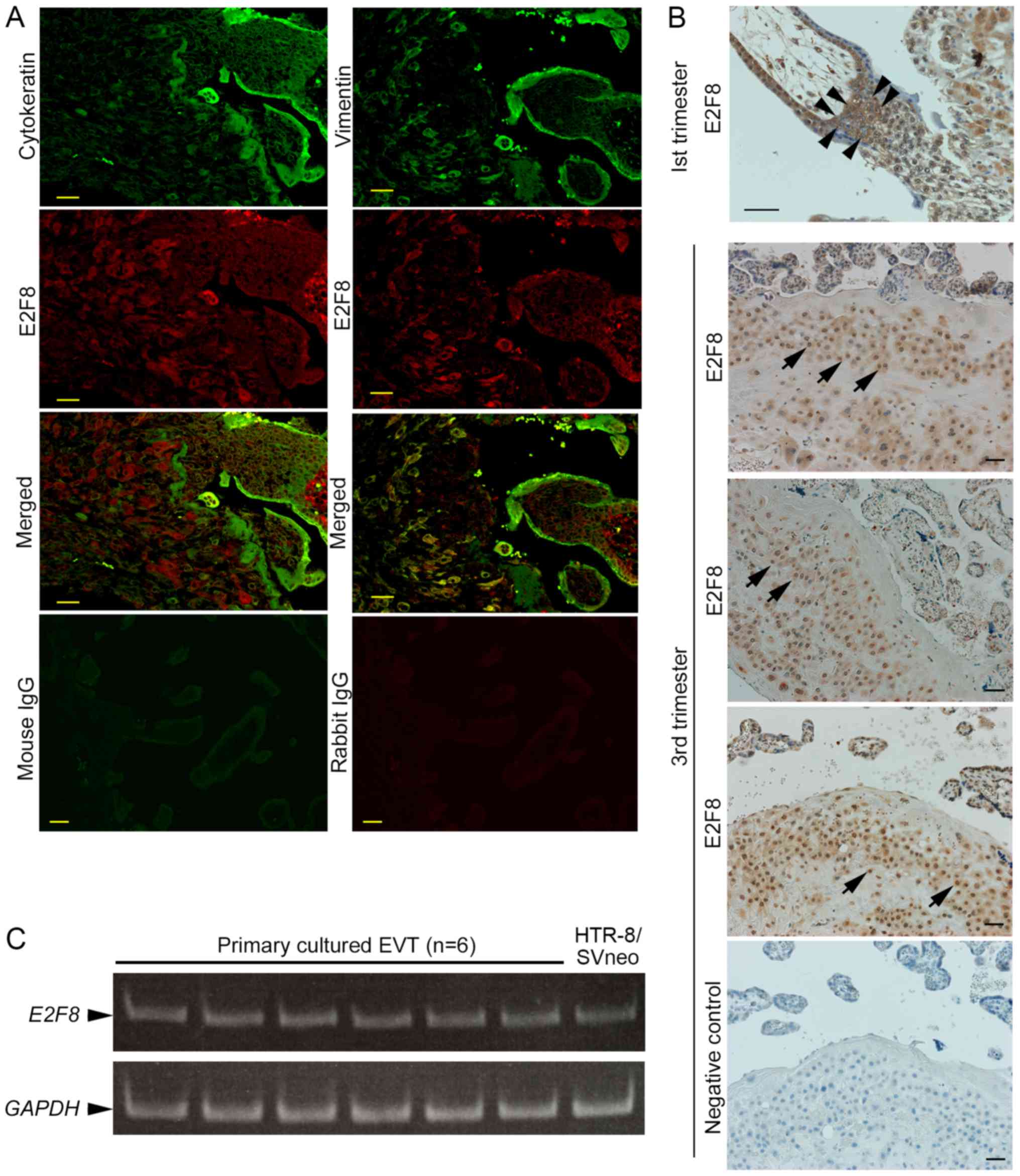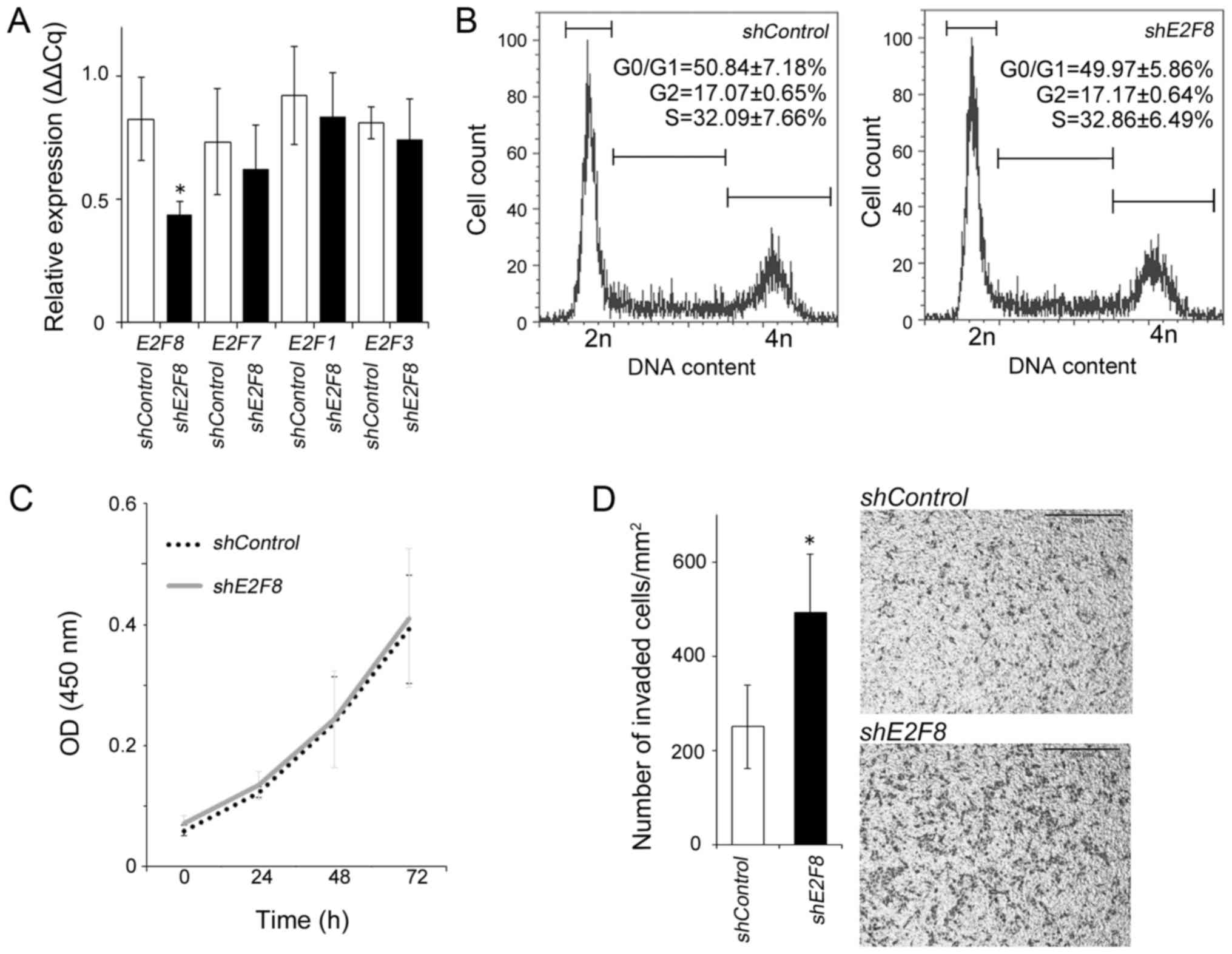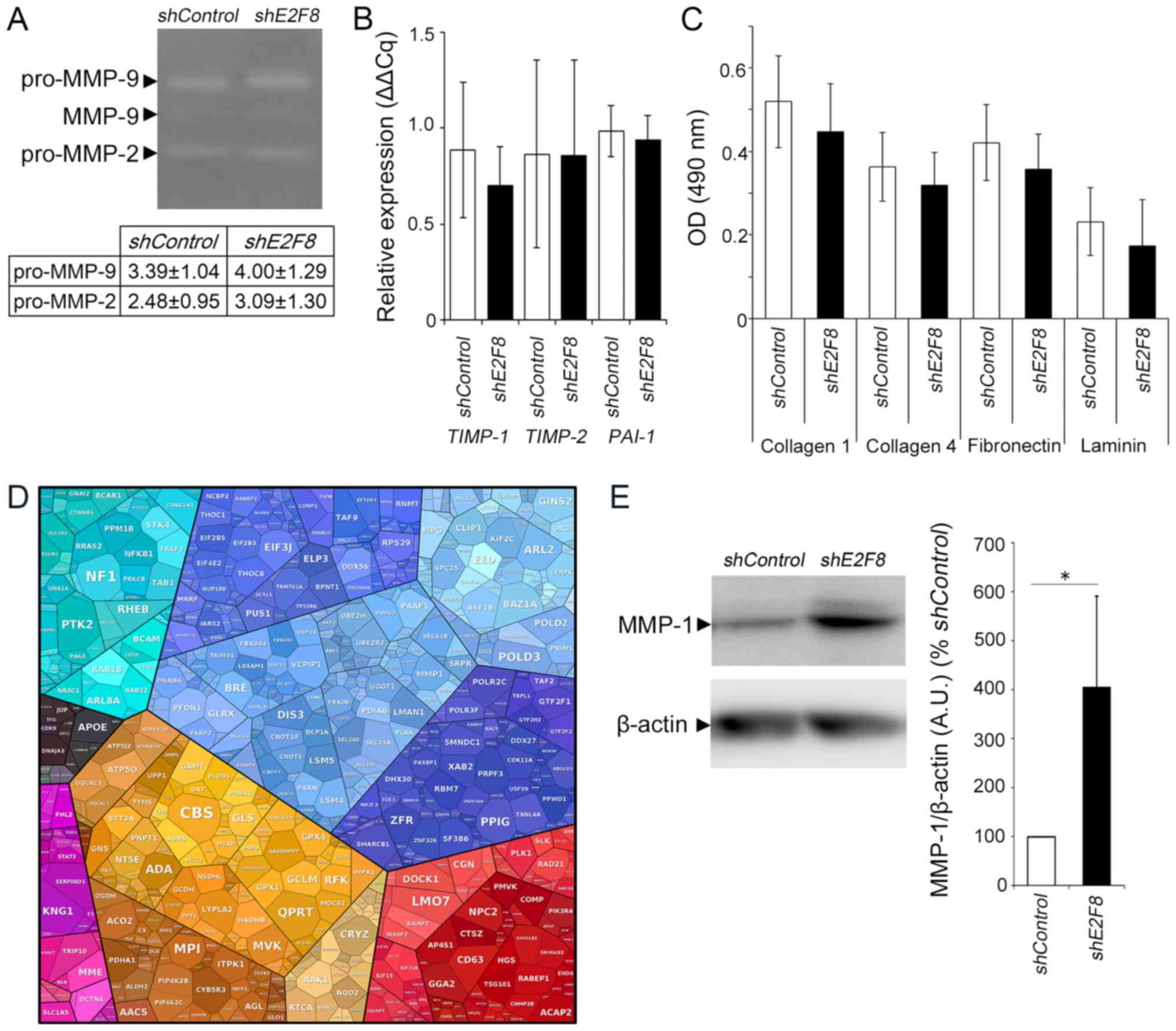|
1
|
Nardozza LM, Caetano AC, Zamarian AC,
Mazzola JB, Silva CP, Marçal VM, Lobo TF, Peixoto AB and Araujo
Júnior E: Fetal growth restriction: Current knowledge. Arch Gynecol
Obstet. 295:1061–1077. 2017. View Article : Google Scholar : PubMed/NCBI
|
|
2
|
Ouseph MM, Li J, Chen HZ, Pécot T, Wenzel
P, Thompson JC, Comstock G, Chokshi V, Byrne M, Forde B, et al:
Atypical E2F repressors and activators coordinate placental
development. Dev Cell. 22:849–862. 2012. View Article : Google Scholar : PubMed/NCBI
|
|
3
|
Weijts BG, Bakker WJ, Cornelissen PW,
Liang KH, Schaftenaar FH, Westendorp B, de Wolf CA, Paciejewska M,
Scheele CL, Kent L, et al: E2F7 and E2F8 promote angiogenesis
through transcriptional activation of VEGFA in cooperation with
HIF1. EMBO J. 31:3871–3884. 2012. View Article : Google Scholar : PubMed/NCBI
|
|
4
|
Bakker WJ, Weijts BG, Westendorp B and de
Bruin A: HIF proteins connect the RB-E2F factors to angiogenesis.
Transcription. 4:62–66. 2013. View Article : Google Scholar : PubMed/NCBI
|
|
5
|
Weijts BG, van Impel A, Schulte-Merker S
and de Bruin A: Atypical E2fs control lymphangiogenesis through
transcriptional regulation of Ccbe1 and Flt4. PLoS One.
8:e736932013. View Article : Google Scholar : PubMed/NCBI
|
|
6
|
Schmidt A, Morales-Prieto DM, Pastuschek
J, Fröhlich K and Markert UR: Only humans have human placentas:
Molecular differences between mice and humans. J Reprod Immunol.
108:65–71. 2015. View Article : Google Scholar : PubMed/NCBI
|
|
7
|
Rossant J and Cross JC: Placental
development: Lessons from mouse mutants. Nat Rev Genet. 2:538–548.
2001. View Article : Google Scholar : PubMed/NCBI
|
|
8
|
Mano Y, Kotani T, Shibata K, Matsumura H,
Tsuda H, Sumigama S, Yamamoto E, Iwase A, Senga T and Kikkawa F:
The loss of endoglin promotes the invasion of extravillous
trophoblasts. Endocrinology. 152:4386–4394. 2011. View Article : Google Scholar : PubMed/NCBI
|
|
9
|
Yamamoto E, Ino K, Miyoshi E, Inamori K,
Abe A, Sumigama S, Iwase A, Kajiyama H, Shibata K, Nawa A and
Kikkawa F: N-acetylglucosaminyltransferase V regulates extravillous
trophoblast invasion through glycosylation of alpha5beta1 integrin.
Endocrinology. 150:990–999. 2009. View Article : Google Scholar : PubMed/NCBI
|
|
10
|
Graham CH, Hawley TS, Hawley RG,
MacDougall JR, Kerbel RS, Khoo N and Lala PK: Establishment and
characterization of first trimester human trophoblast cells with
extended lifespan. Exp Cell Res. 206:204–211. 1993. View Article : Google Scholar : PubMed/NCBI
|
|
11
|
Livak KJ and Schmittgen TD: Analysis of
relative gene expression data using real-time quantitative PCR and
the 2(-Delta Delta C(T)) method. Methods. 25:402–408. 2001.
View Article : Google Scholar : PubMed/NCBI
|
|
12
|
Matsumoto K, Miki R, Nakayama M, Tatsumi N
and Yokouchi Y: Wnt9a secreted from the walls of hepatic sinusoids
is essential for morphogenesis, proliferation, and glycogen
accumulation of chick hepatic epithelium. Dev Biol. 319:234–247.
2008. View Article : Google Scholar : PubMed/NCBI
|
|
13
|
Kajiyama H, Shibata K, Terauchi M, Ino K,
Nawa A and Kikkawa F: Involvement of SDF-1alpha/CXCR4 axis in the
enhanced peritoneal metastasis of epithelial ovarian carcinoma. Int
J Cancer. 122:91–99. 2008. View Article : Google Scholar : PubMed/NCBI
|
|
14
|
Moriyama Y, Kotani T, Ushida T, Imai K,
Nakano T, Tsuda H and Kikkawa F: Altered proteomic profile in
umbilical arterial serum from mothers with schizophrenia. Schizophr
Res. (pii)S0920-9964:30101–30104. 2018.
|
|
15
|
Sun Y, Gao C, Wang X, Yuan Y, Liu Y and
Jia J: Serum quantitative proteomic analysis of patients with
keshan disease based on iTRAQ labeling technique: A first term
study. J Trace Elem Med Biol. 44:331–338. 2017. View Article : Google Scholar : PubMed/NCBI
|
|
16
|
Liu X, Wang J, Gao L, Liu H and Liu C:
iTRAQ-based proteomic analysis of neonatal kidney from offspring of
protein restricted rats reveals abnormalities in intraflagellar
transport proteins. Cell Physiol Biochem. 44:185–199. 2017.
View Article : Google Scholar : PubMed/NCBI
|
|
17
|
Qi QR, Zhao XY, Zuo RJ, Wang TS, Gu XW,
Liu JL and Yang ZM: Involvement of atypical transcription factor
E2F8 in the polyploidization during mouse and human
decidualization. Cell Cycle. 14:1842–1858. 2015. View Article : Google Scholar : PubMed/NCBI
|
|
18
|
Tang Q, Wu W, Xu X, Huang L, Gao Q, Chen
H, Sun H, Xia Y, Sha J, Wang X, et al: miR-141 contributes to fetal
growth restriction by regulating PLAG1 expression. PLoS One.
8:e587372013. View Article : Google Scholar : PubMed/NCBI
|
|
19
|
Kaitu'u-Lino TJ, Hastie R, Cannon P,
Nguyen H, Lee S, Hannan NJ and Tong S: Transcription factors E2F1
and E2F3 are expressed in placenta but do not regulate MMP14.
Placenta. 36:932–937. 2015. View Article : Google Scholar : PubMed/NCBI
|
|
20
|
Chong JL, Tsai SY, Sharma N, Opavsky R,
Price R, Wu L, Fernandez SA and Leone G: E2f3a and E2f3b contribute
to the control of cell proliferation and mouse development. Mol
Cell Biol. 29:414–424. 2009. View Article : Google Scholar : PubMed/NCBI
|
|
21
|
Wu L, Timmers C, Maiti B, Saavedra HI,
Sang L, Chong GT, Nuckolls F, Giangrande P, Wright FA, Field SJ, et
al: The E2F1-3 transcription factors are essential for cellular
proliferation. Nature. 414:457–462. 2001. View Article : Google Scholar : PubMed/NCBI
|
|
22
|
Lian IA, Toft JH, Olsen GD, Langaas M,
Bjørge L, Eide IP, Børdahl PE and Austgulen R: Matrix
metalloproteinase 1 in pre-eclampsia and fetal growth restriction:
reduced gene expression in decidual tissue and protein expression
in extravillous trophoblasts. Placenta. 31:615–620. 2010.
View Article : Google Scholar : PubMed/NCBI
|
|
23
|
Nystad M, Sitras V, Larsen M and Acharya
G: Placental expression of aminopeptidase-Q (laeverin) and its role
in the pathophysiology of preeclampsia. Am J Obstet Gynecol.
211:686.e1–31. 2014. View Article : Google Scholar
|
|
24
|
Suman P and Gupta SK: Comparative analysis
of the invasion-associated genes expression pattern in first
trimester trophoblastic (HTR-8/SVneo) and JEG-3 choriocarcinoma
cells. Placenta. 33:874–877. 2012. View Article : Google Scholar : PubMed/NCBI
|
|
25
|
Morgunova E, Yin Y, Jolma A, Dave K,
Schmierer B, Popov A, Eremina N, Nilsson L and Taipale J:
Structural insights into the DNA-binding specificity of E2F family
transcription factors. Nat Commun. 6:100502015. View Article : Google Scholar : PubMed/NCBI
|
|
26
|
Schaal C, Pillai S and Chellappan SP: The
Rb-E2F transcriptional regulatory pathway in tumor angiogenesis and
metastasis. Adv Cancer Res. 121:147–182. 2014. View Article : Google Scholar : PubMed/NCBI
|
|
27
|
Johnson JL, Pillai S, Pernazza D, Sebti
SM, Lawrence NJ and Chellappan SP: Regulation of matrix
metalloproteinase genes by E2F transcription factors: Rb-Raf-1
interaction as a novel target for metastatic disease. Cancer Res.
72:516–526. 2012. View Article : Google Scholar : PubMed/NCBI
|
|
28
|
Bilban M, Tauber S, Haslinger P,
Pollheimer J, Saleh L, Pehamberger H, Wagner O and Knöfler M:
Trophoblast invasion: Assessment of cellular models using gene
expression signatures. Placenta. 31:989–996. 2010. View Article : Google Scholar : PubMed/NCBI
|
|
29
|
Maiti B, Li J, de Bruin A, Gordon F,
Timmers C, Opavsky R, Patil K, Tuttle J, Cleghorn W and Leone G:
Cloning and characterization of mouse E2F8, a novel mammalian E2F
family member capable of blocking cellular proliferation. J Biol
Chem. 280:18211–18220. 2005. View Article : Google Scholar : PubMed/NCBI
|
|
30
|
Thurlings I, Martínez-López LM, Westendorp
B, Zijp M, Kuiper R, Tooten P, Kent LN, Leone G, Vos HJ, Burgering
B and de Bruin A: Synergistic functions of E2F7 and E2F8 are
critical to suppress stress-induced skin cancer. Oncogene.
36:829–839. 2017. View Article : Google Scholar : PubMed/NCBI
|












